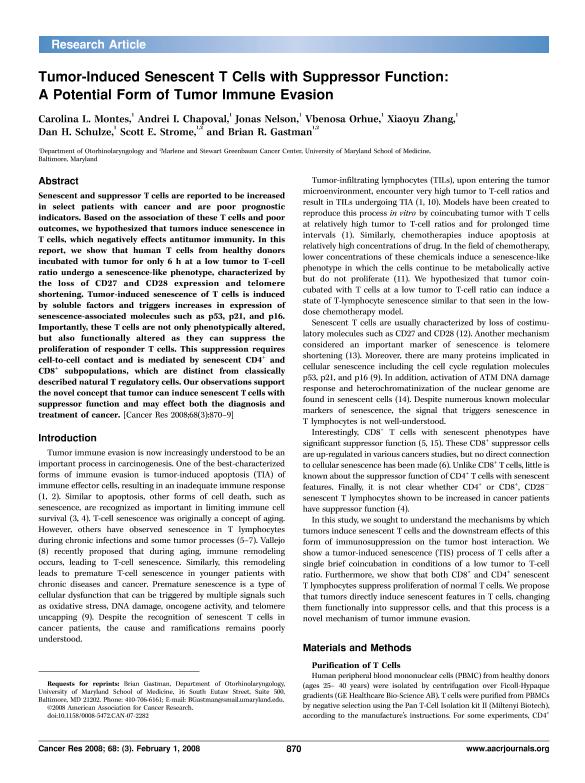Mostrar el registro sencillo del ítem
dc.contributor.author
Montes, Carolina Lucia

dc.contributor.author
Chapoval, Andrei I.
dc.contributor.author
Nelson, Jonas
dc.contributor.author
Orhue, Vbenosa
dc.contributor.author
Zhang, Xiaoyu
dc.contributor.author
Schulze, Dan H.
dc.contributor.author
Strome, Scott E.
dc.contributor.author
Gastman, Brian R.
dc.date.available
2021-05-20T15:23:24Z
dc.date.issued
2008-02
dc.identifier.citation
Montes, Carolina Lucia; Chapoval, Andrei I.; Nelson, Jonas; Orhue, Vbenosa; Zhang, Xiaoyu; et al.; Tumor-induced senescent T cells with suppressor function: A potential form of tumor immune evasion; American Association for Cancer Research; Cancer Research; 68; 3; 2-2008; 870-879
dc.identifier.issn
0008-5472
dc.identifier.uri
http://hdl.handle.net/11336/132360
dc.description.abstract
Senescent and suppressor T cells are reported to be increased in select patients with cancer and are poor prognostic indicators. Based on the association of these T cells and poor outcomes, we hypothesized that tumors induce senescence in T cells, which negatively effects antitumor immunity. In this report, we show that human T cells from healthy donors incubated with tumor for only 6 h at a low tumor to T-cell ratio undergo a senescence-like phenotype, characterized by the loss of CD27 and CD28 expression and telomere shortening. Tumor-induced senescence of T cells is induced by soluble factors and triggers increases in expression of senescence-associated molecules such as p53, p21, and p16. Importantly, these T cells are not only phenotypically altered, but also functionally altered as they can suppress the proliferation of responder T cells. This suppression requires cell-to-cell contact and is mediated by senescent CD4+ and CD8+ subpopulations, which are distinct from classically described natural T regulatory cells. Our observations support the novel concept that tumor can induce senescent T cells with suppressor function and may effect both the diagnosis and treatment of cancer. ©2008 American Association for Cancer Research.
dc.format
application/pdf
dc.language.iso
eng
dc.publisher
American Association for Cancer Research

dc.rights
info:eu-repo/semantics/openAccess
dc.rights.uri
https://creativecommons.org/licenses/by-nc-sa/2.5/ar/
dc.subject
Senescence
dc.subject
T cell
dc.subject
Tumor
dc.subject
Immunology
dc.subject.classification
Inmunología

dc.subject.classification
Medicina Básica

dc.subject.classification
CIENCIAS MÉDICAS Y DE LA SALUD

dc.title
Tumor-induced senescent T cells with suppressor function: A potential form of tumor immune evasion
dc.type
info:eu-repo/semantics/article
dc.type
info:ar-repo/semantics/artículo
dc.type
info:eu-repo/semantics/publishedVersion
dc.date.updated
2021-04-23T17:15:54Z
dc.identifier.eissn
1538-7445
dc.journal.volume
68
dc.journal.number
3
dc.journal.pagination
870-879
dc.journal.pais
Estados Unidos

dc.journal.ciudad
Philadelphia
dc.description.fil
Fil: Montes, Carolina Lucia. Consejo Nacional de Investigaciones Científicas y Técnicas. Centro Científico Tecnológico Córdoba. Centro de Investigaciones en Bioquímica Clínica e Inmunología; Argentina
dc.description.fil
Fil: Chapoval, Andrei I.. University of Maryland; Estados Unidos
dc.description.fil
Fil: Nelson, Jonas. University of Maryland; Estados Unidos
dc.description.fil
Fil: Orhue, Vbenosa. University of Maryland; Estados Unidos
dc.description.fil
Fil: Zhang, Xiaoyu. University of Maryland; Estados Unidos
dc.description.fil
Fil: Schulze, Dan H.. University of Maryland; Estados Unidos
dc.description.fil
Fil: Strome, Scott E.. University of Maryland; Estados Unidos
dc.description.fil
Fil: Gastman, Brian R.. University of Maryland; Estados Unidos
dc.journal.title
Cancer Research

dc.relation.alternativeid
info:eu-repo/semantics/altIdentifier/doi/http://dx.doi.org/10.1158/0008-5472.CAN-07-2282
dc.relation.alternativeid
info:eu-repo/semantics/altIdentifier/url/https://cancerres.aacrjournals.org/content/68/3/870
Archivos asociados
